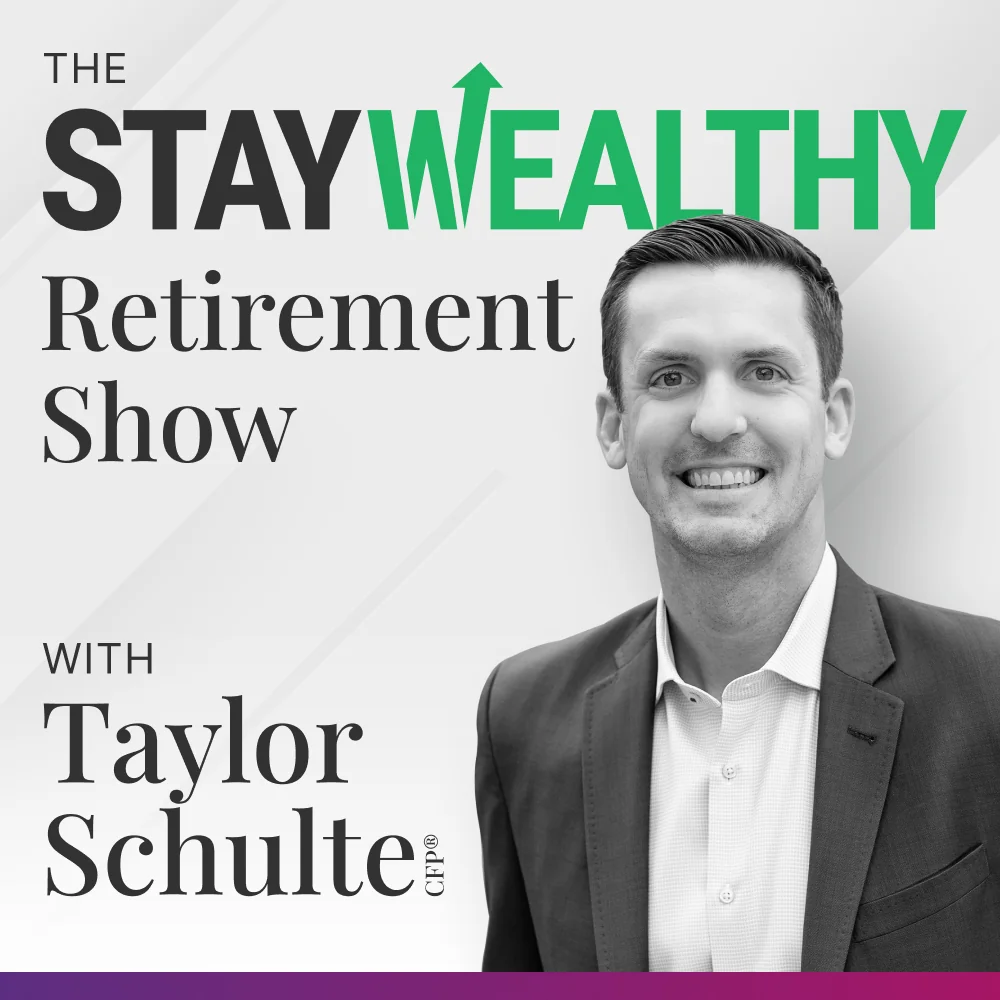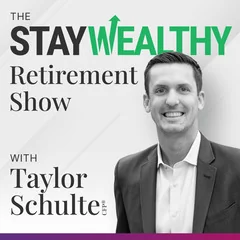“I planned for 30 years of expenses—but zero years of purpose.”
This was a recent client’s confession, and she’s not alone.
In fact, nearly 40% of retirees say they wish they had waited longer to retire (and it’s not about money).
In this episode, I’m revealing why even the most financially prepared retirees fall into identity crises and regret.
I’m also sharing my 5-step Bridge Strategy to help you retire with clarity and purpose, not just a seven-figure portfolio.
If you’re planning FOR retirement but haven’t considered what you’re retiring TO, this episode is for you.
Listen To This Episode On:
When You’re Ready, Here Are 3 Ways I Can Help You:
- Get Your FREE Retirement & Tax Analysis. Learn how to improve retirement success + lower taxes.
- Listen to the Stay Wealthy Retirement Show. An Apple Top 50 investing podcast.
- Join My Retirement Newsletter. Weekly retirement and investing tips (delivered to our inbox!)
+ Episode Resources
+ Transcript: How to Avoid Retirement Regret
A client recently told me, “I planned for 30 years of expenses—but zero years of purpose.”
And she’s not alone.
According to the National Bureau of Economic Research, more than 1 in 3 retirees say they wish they had waited longer to retire.
It’s not about money. It’s about meaning.
So, today, I’m going to break it all down. First, I’m going to share exactly why the retire as early as possible movement is quietly backfiring for so many people, and then I’m going to walk you through my 5-step bridge framework to help you retire successfully, with purpose, not regret.
The Hidden Cost of Early Retirement
The Freedom Trap
Early retirement sounds like freedom. No more commutes, no more meetings, no more deadlines.
But that freedom often comes with an unexpected price tag, leading many to wonder if they made a big mistake.
As I just mentioned, more than 1 in 3 retirees wished they had waited longer to retire—37% to be exact.
And here’s the kicker: early retirement regrets don’t typically get better with time—they compound.
It turns out: no amount of spreadsheets, simulations, or clever withdrawal strategies can prepare you for the emotional challenges retirement can create.
The Identity Crisis
A family friend recently said something that stuck with me. She said, “Retirement gave me everything I wanted, except direction.”
And she’s not the only one faced with that challenge.
In fact, one academic study found that nearly 50% of retirees experience some form of identity crisis during their transition.
There’s also the mental challenge of second-guessing the retirement decision itself. What once felt like freedom can, over time, trigger doubt. Was this the right decision? Did I retire too early? Should I have handled this major life decision differently?
The Loss of Purpose and Validation
Many retirees begin to reflect on lost opportunities, not necessarily for financial gain, but for the sense of fulfillment their jobs brought.
Work often gives people a way to measure progress and validate their contributions, and without it, they’re left questioning where their efforts should go.
Now that we understand the hidden emotional and psychological costs of early retirement, let’s take a look at the main problem when it comes to retirement beliefs.
The Core Problem: Retiring Without Clarity
First, let me be extra clear—early retirement does not always lead to an unfulfilling experience.
But when people don’t know what they’re retiring to, they either jump too soon and end up feeling aimless… or they delay retirement indefinitely, hoping the answer will somehow show up.
In reality, it rarely does.
One More Year Syndrome
I recently caught up with a client who was faced with this very dilemma when she hired me, and I asked her about that time period.
She said:
“I remember telling myself that I needed to save more money—but really, looking back on it, I just didn’t know what I’d do with my time. It felt easier to keep working than to face that.”
The technical term for this is the “One More Year Syndrome.”
Some like to joke about it. As if delaying retirement is always just about irrational fears or perfectionism. But for many people, it’s actually a signal that something important is missing.
And that something is clarity.
The Alternative Path Missed
But clarity isn’t found overnight. It can take time to find, which is why many early retirement seekers really just need a shift or a change, not a complete stop.
Sam Dogen (Doh-gun), a well-known early retirement author, wrote:
“If I’d stayed one more year, I would’ve pursued a new role in another office. That might’ve rejuvenated my whole relationship with work.”
Alternative career paths—ones with better culture, more flexibility, or deeper meaning—are often what people were searching for all along. But when you frame retirement as the only exit, you miss those opportunities.
Beyond Financial Security
And when you leave without clarity and purpose, even a perfectly executed financial plan can’t protect you from feeling lost.
Because financial security is just one piece of the puzzle.
The rest?
That’s who you are when the job title disappears.
Recognizing how deeply retirement regrets can impact even the most successful retirees, it’s worth asking:
What does a better approach actually look like?
And how can you start building it—intentionally—before it’s too late?
That’s exactly what my team and I do every day.
If you want help applying these ideas to your own situation, click the first link in the description to book a discovery call with us.
Now, let me show you what a great retirement actually looks like—and how to start building it today.
What Great Retirement Actually Looks Like
So, if retiring without purpose leads to regret… what does a great retirement actually look like?
It looks like confidence. Direction. Energy. Not just freedom.
Because the goal isn’t to retire as early as possible. It’s to retire into a life that’s actually worth living.
And that starts with knowing what you want from this next chapter—not just financially, but emotionally, socially, and personally.
The Research on Fulfilled Retirees
In fact, studies show that the most fulfilled retirees are not the ones with the biggest portfolios.
They’re the ones who have built lives filled with purpose, structure, and intention long before their final day of work
They didn’t wait until retirement to figure it out—they took baby steps and made small, meaningful commitments that helped them successfully make this major life transition.
Real Examples of Purpose in Progress
Let me give you a few real examples:
- A physician I worked with started mentoring young professionals once a week, before she retired.
- A neighbor of mine turned his woodworking hobby into a side business two years before leaving his role at Qualcomm.
- An engineer couple we’ve done a lot of tax planning work for blocked time every month a few years before retirement to volunteer at their local animal shelter.
These aren’t retirement fantasies. They’re purpose-in-progress.
The Combined Impact
And when you combine that kind of purpose clarity with financial stability, the impact is massive.
Stress drops. Confidence rises. And decisions—about when to retire, how much to spend, what to do next—become easier.
Because you’re not just financially ready… you’re life-ready.
The 5-Step Bridge Strategy
I know what you’re thinking right now.
“Taylor, this all sounds great, but how exactly do I take action here? What steps do I actually take to avoid joining this generation of regretful retirees?”
You build a bridge.
No, not a metaphorical one. I’m talking about a real, structured, purpose-driven transition from work to retirement.
I call this “The Bridge Strategy”, and I’ve broken it into 5 simple steps for you.
Here’s exactly how it works:
Step 1: Identify Your Pillars
Start with clarity. Clarity on your values, interests, and your vision for retirement.
What excites you? What gives you a sense of identity outside of work? Who do you want to spend your time with, and how?
And financially, how much of your lifestyle is already covered by guaranteed income or a withdrawal strategy? How much flexibility do you really have?
When you combine self-reflection with financial confidence, you give yourself space to start designing a life with purpose.
Step 2: Explore Bridge Candidates
This is where you begin exploring possibilities.
These could be paid or unpaid. Teaching, coaching, volunteering, creating, mentoring.
My father-in-law, for example, went through training to become a volunteer at the San Diego Wild Animal Park. He gets joy, structure, and social connection—without needing to fully stop working.
And yes, some bridges can generate income. But ask yourself: do you need that income, or do you just want the activity?
Step 3: Test and Tinker
Here’s where things get real. You start testing.
Choose one or two bridge ideas. Commit 5–10 hours a month. And while you’re still working, pay attention:
Are you energized? Drained? Excited to keep going?
You’ll use this time to stress test your finances, too. How healthy is your plan? If you scale back at work, could your portfolio support the difference? Would this open the door for strategic Roth conversions or tax planning opportunities?
Step 4: Strengthen the Structure
Once you’ve found a bridge that clicks, reinforce it.
Build a schedule. Create accountability. And perhaps most importantly, join a community of people who share your purpose.
This is also when you begin coordinating the financial pieces: health insurance before Medicare, Social Security timing, portfolio income strategies, and risk management.
In this step, you’re building emotional and financial readiness in parallel.
Step 5: Cross with Confidence
Finally, Step #5: Cross with Confidence
This is the payoff. Retirement should no longer feel like a leap—it should feel like a natural next step.
You’ll know you’re ready when:
- You’ve tested your bridges in real life.
- You know what a fulfilling week looks like.
- You’ve replaced the structure, connection, and purpose that your job once provided.
- And your financial plan supports the life you’re moving into.
You’ve removed the guesswork. You’ve softened the identity shift.
And you’ve built YOUR unique version of retirement that’s grounded in clarity, purpose, and peace of mind.
Because this isn’t just about stopping work. It’s about starting something better.




